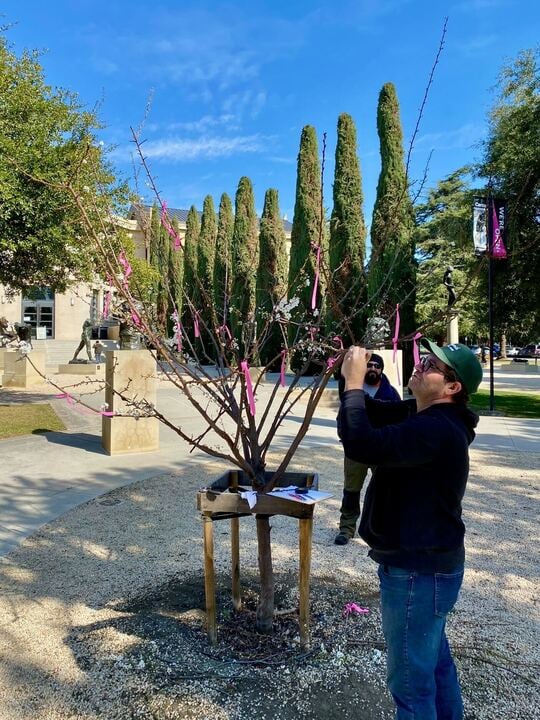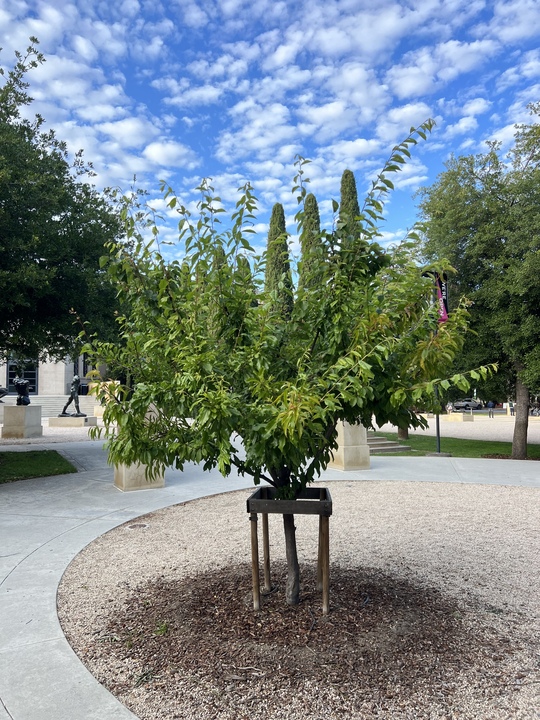A living art installation has planted its roots near the Rodin Sculpture Garden. The art is a tree capable of growing 40 varieties of stone fruits, highlighting themes that branch out into the realms of aesthetics, social commentary and fruitful delight. Created by artist and Syracuse University professor Sam Van Aken, the piece was commissioned by Stanford’s Public Art Committee in 2019.
Stone fruits, also known as drupes, are fruits with a pit at their center. A juicy jumble of such fruits, ranging from peaches to plums and even almonds, will dangle from the tree’s grafted branches.
Van Aken has created other iterations of the Tree of 40 Fruit around the United States, including in Syracuse and Louisville, Kentucky. According to him, the idea for these living art pieces stemmed from multiple interests, including aesthetic appeal, providing commentary on food insecurity and a passion for horticulture.
“I don’t think I’m making something so much as I’m definitely a collaborator in a process,” said Van Aken, reflecting on his role in bringing the Tree of 40 Fruit to Stanford.
Deborah Cullinan, Vice President of the Arts at Stanford and Co-Chair of the Public Art Committee, wrote in an email to The Daily that the Tree of 40 Fruit was picked for campus installation for a handful of reasons. In addition to the tree’s dynamic nature, it was also “meaningful that the Tree of 40 Fruit uses a creative form to engage issues of the environment and sustainability,” wrote Cullinan.
Fruit trees go bananas for California’s Mediterranean climate. According to Van Aken, creating the Tree of 40 Fruit was easier in California as compared to New York, given that California has “perfect temperatures,” although providing water “is the issue” since fruit trees are known to be notorious water-guzzlers. Whereas it takes three years to graft a tree in California, it takes five years in upstate New York.

Grafting is a relatively straightforward but precise process. According to Bay Area arborist Dave Muffly ’88, a scion, the variety to be appended to the base tree, is collected with the width around “the thickness of a pencil.” A root stalk is cut to the same diameter as the scion, the two stalks are aligned with slanted cuts, then wrapped together with tape. Muffly said the process is done mostly in winter.
“If everything has matched up and is relatively undamaged,” the scion and root stalk “will grow together and fuse,” he said.
According to Van Aken, the base of the tree in the Rodin Sculpture Garden is a Santa Rosa plum. Since “California has very strict agricultural regulations,” he depended upon the National Clonal Germplasm Repository at the University of California, Davis to obtain the scions.
Van Aken said he uses electrical tape “to seal the wound” since as the stalk grows, “[the tape] expands with it.” According to him, the trickiest part of the grafting process is deciding when to add the next graft. He does have a sweet spot, though.
“When you can start to see the growth buds start to swell, you have about 10 days” to complete the next graft, he said.
Silicon Valley was once known as the “Valley of the Heart’s Delight,” in part for its cornucopia of fruit orchards. The tree pays homage to local fruit varieties such as the almond and Santa Rosa plum.
Some of the fruits are more finicky to grow than others. For instance, “almonds are not known to produce well in the Bay Area,” Muffly said. On the other hand, the Santa Rosa plum, which is “maybe the most common fruit tree in coastal California [is] super easy to grow.”
Stanford’s Tree of 40 Fruit may grow to be around 17 to 18 feet wide and if left unpruned, it may grow to be 16 to 17 feet tall and may live up to 50 years, according to Van Aken.
Muffly expects that “one of [the varieties] would win” if the tree were left to its own devices. Since stone fruits thrive with full sun, it might be a little challenging “to both manage the varieties and manage the sun penetration,” he said.
Although the Committee is yet to plant a sign identifying the tree, visitors may peruse the Stanford Mobile app for more details about public art installations. According to Cullinan, the location was selected given its proximity to other arts institutions at Stanford—including the McMurtry Building, Cantor Arts Center and Anderson Collection.
As the summer approaches, the tree will continue blossoming and the fruits will ripen. Cullinan wrote that the late spring and summer are “the primary season[s] for stone fruit.”
Who may enjoy the fruits of the tree’s labor? According to Cullinan, the tree is open for general consumption and passersby are invited to pluck fruit when it has ripened.
Hungry Stanford students are now in a plum position, having to look no further than Roth Way in search of study snacks. Timmy Robertson ’23 M.S. ’24 agreed: “I’m not usually a fan of stone fruit, but I would definitely try some from this tree,” said Robertson.
Although Robertson did not expect the tree to be an art installation, he said “Van Aken’s description of fruit as cultural objects helped me appreciate it as a work of art.”
“I love stone fruit. I had a peach tree I took care of growing up,” Theodore Kanell ’23 M.S. ’24 said. He added that he is “fascinated by the idea of a living piece of art,” and would be interested in observing the tree’s growth.
